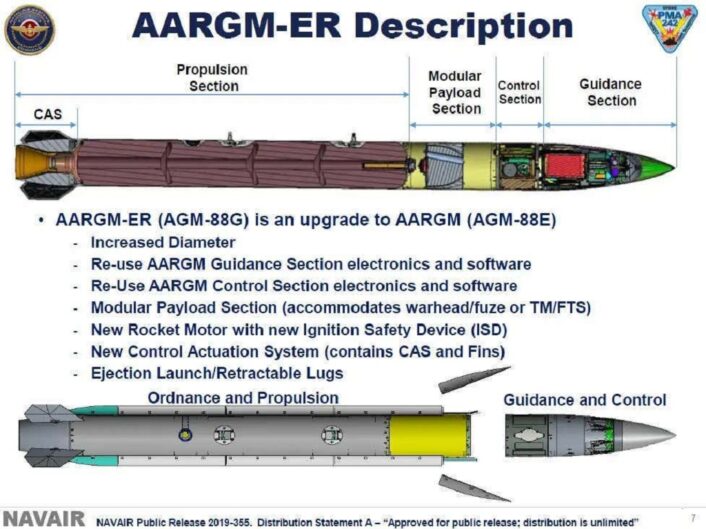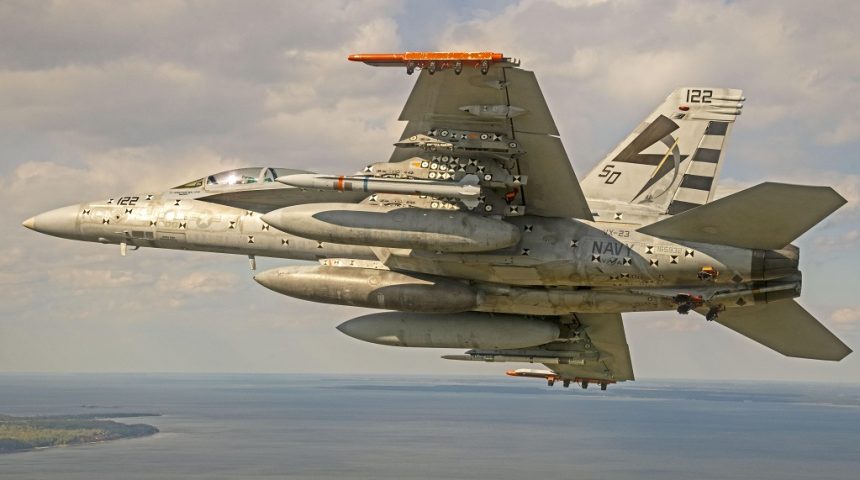The live fire event is the first in a series of development test events that will ensure AARGM-ER can meet required objectives as it is about to enter Low Rate Initial Production.
The U.S. Navy recently disclosed that the AGM-88G Advanced Anti-Radiation Guided Missile – Extended Range (AARGM-ER) was successfully launched from an F/A-18 Super Hornet during its first live fire event on July 19, 2021, off the coast of Point Mugu Sea Test Range, meeting all planned test objectives.
“This first live fire event is a major step to providing our fleet with the most advanced weapon system to defeat evolving surface-to-air threats”, said Capt. Alex Dutko, Direct and Time Sensitive Strike Weapon (PMA-242) program manager. “Our Navy and Northrop Grumman team has done tremendous work executing this event and ensuring we met all test objectives.”
The first live fire test validated the overall system integration, performance of the rocket motor and the start of modeling and simulation validation. This was the first in a series of development test events that will ensure AARGM-ER can meet required objectives. Few more details were provided in Northrop Grumman’s press release, which stated that the government and industry team was able to conduct this test event three months earlier than originally envisioned and that the missile successfully demonstrated the long range capability of the new missile design.
“This firing was a significant milestone for the program as we get ready to enter Low Rate Initial Production (LRIP),” added Keli Olea, PMA-242 AARGM-ER Co-Lead. The program is expected to enter LRIP this summer, which will support future deployment of the AARGM-ER to the fleet and initial operating capability.
This milestone follows the first captive flight in April 2021, when the AARGM-ER was flown under the wing of an F/A-18F Super Hornet, demonstrating that it could communicate with the aircraft and that is compatible with the Super Hornet’s performance envelope.

The AARGM-ER is the evolution of the latest variant of the AGM-88 HARM (High-Speed Anti-Radiation Missile), the AGM-88E AARGM, a medium-range air-to-ground missile employed for Suppression and/or Destruction of Enemy Air Defenses (SEAD/DEAD). The AGM-88E is the result of a cooperative program with the Italian Air Force started in 2005 and developed as an upgrade and compliment to the AGM-88B/C. The AARGM program designed and produced a new Guidance Section and modified the existing Control Section, which are coupled with the legacy HARM Rocket Motor and Warhead Section, wings and fins.
The new Guidance Section features a passive anti-radiation homing receiver, satellite and inertial navigation system and a millimeter wave radar for terminal guidance, with the added ability to send images of the target via a satellite link before impact. The purpose of these new Guidance Section is to improve the effectiveness of the legacy HARM, especially against enemy radar and communications sites that would shut down to confuse incoming anti-radiation missiles (counter-shutdown capability) or pop-up threats.
As stated by the U.S. Navy, AARGM baseline capabilities include an expanded target set, counter-shutdown capability, advanced signals processing for improved detection and locating, geographic specificity providing aircrew the opportunity to define missile-impact zones and impact-avoidance zones, and a weapon impact-assessment broadcast capability providing for battle damage assessment cueing.
The AARGM-ER builds up on these capabilities to obtain an even more advanced weapon that is being integrated on the F/A-18E/F Super Hornet and EA-18G Growler and it is compatible for a future integration on all the variants of the F-35 Lightning II. The AARGM-ER combines the Guidance Section and Control Section of the AGM-88E with a new, larger rocket motor and a new warhead. The control surfaces have been redesigned too, obtaining aerodynamic strakes along the sides for increased lift and low-drag tail surfaces. The missile will reportedly have roughly double the range and speed of the AGM-88E.
One of the factors behind the AGM-88G design was the need for the missile to fit inside the F-35’s weapons bays, as the previous versions of the AGM-88 can’t fit because of their large control fins. So, until the missile is ready for fielding, the F-35’s SEAD capability is mostly reliant on its AESA (Active Electronically Scanned Array) radar with sophisticated electronic attack capabilities, including false targets, network attack, advanced jamming and algorithm-packed data streams.








